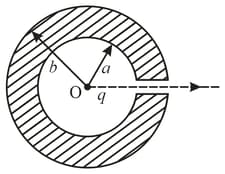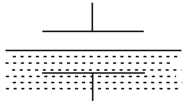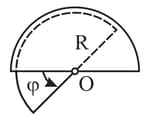A point charge is located at the centre of a spherical uncharged conducting layer, provided with a small orifice (figure). The inside and outside radii of the layer are equal to and , respectively. What amount of work has to be performed to slowly transfer the charge from the point , through the orifice and into infinity?



Important Questions on ELECTRODYNAMICS
Each plate of a parallel-plate air capacitor has an area . What amount of work has to be performed to slowly increase the distance between the plates from to , if
(a) the charge of the capacitor, which is equal to or
(b) the voltage across the capacitor, which is equal to , is kept constant in the process?
Inside a parallel-plate capacitor, there is a plate parallel to the outer plates, whose thickness is equal to of the gap width. When the plate is absent, the capacitor capacitance equals . First, the capacitor was connected in parallel to a constant voltage source, producing , then it was disconnected from it, after which the plate was slowly removed from the gap. Find the work performed during the removal, if the plate is
(a) made of metal;
(b) made of glass.
(Permittivity of vacuum, )
A parallel-plate capacitor is located horizontally, so that one of its plates is submerged into liquid while the other is over its surface (figure). The permittivity of the liquid is equal to , its density is equal to . To what height will the level of the liquid in the capacitor rise after its plates get a charge of surface density ?

A capacitor consists of two stationary plates shaped as a semi-circle of radius , and a movable plate made of a dielectric with permittivity , and capable of rotating about an axis between the stationary plates (figure). The thickness of the movable plate is equal to , which is practically the separation between the stationary plates. A potential difference is applied to the capacitor. Find the magnitude of the moment of forces relative to the axis , acting on the movable plate in the position shown in the figure.

(a) in series;
(b) in parallel.
